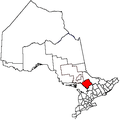Callander, Ontario
| Callander | |
|---|---|
| Municipality (single-tier) | |
| Municipality of Callander | |
|
Main Street in Callander | |
| Motto: Four Seasons of Reasons | |
 Callander Location of Callander in Ontario | |
| Coordinates: 46°13′N 79°22′W / 46.217°N 79.367°W | |
| Country |
|
| Province |
|
| District | Parry Sound |
| Established | 1891 |
| Government | |
| • Type | Township |
| • Mayor | Hector Lavigne |
| • MP | Jay Aspin |
| • MPP | Victor Fedeli |
| Area[1] | |
| • Land | 105.97 km2 (40.92 sq mi) |
| • Metro | 788.48 km2 (304.43 sq mi) |
| Population (2011) | |
| • Municipality (single-tier) | 3,864 |
| • Density | 36.5/km2 (95/sq mi) |
| Time zone | EST (UTC−5) |
| • Summer (DST) | EDT (UTC−4) |
| Area code(s) | 705 |
| Website | Municipality of Callander |

The Municipality of Callander (formerly the Township of North Himsworth) is a township in central Ontario, Canada, located at the southeast end of Lake Nipissing in the Almaguin Highlands region of the District of Parry Sound. The municipality is located on Callander Bay, just south of North Bay.
The municipality renamed itself from North Himsworth to Callander in 2003, adopting the name of its major community because, in the words of then-mayor Bill Brazeau, "Nobody knew where North Himsworth was."[2]
Communities
The main community of Callander is located in the northeast corner of the municipality, along the eastern shore of Callander Bay.
The south shore of Callander Bay and Lake Nipissing (southwest of the town) represents the rural population of Callander, which primarily runs along Highway 654 West. This area includes the communities of Wisawasa and Lighthouse Beach.
History
Callander Bay is an eroded Proterozoic volcanic pipe formed by the violent, supersonic eruption of a deep-origin volcano, approximately 500 million years ago. It is one of eight known volcanic sites in Ontario, including the Manitou Islands in North Bay.
The first people in the Callander area were of Ojibwa and Algonquin descent who have lived around Lake Nipissing for about 9,400 years. Though in history known by many names, they are currently known as Nipissing First Nation. They are generally considered part of the Anishinaabe peoples, a grouping which includes the Odaawaa, Ojibwe and Algonquins.
In 1610, French explorer Samuel de Champlain sent a young apprentice, Étienne Brûlé, to live with the Huron natives at Georgian Bay. While on route, Brûlé discovered Lake Nipissing via the Lavase River Portage (approximately 3 km north of Callander) and established a major fur trading route linking the Ottawa River with the upper Great Lakes. Other explorers who used the Lavase Portage were Samuel de Champlain in 1615, Pierre Gaultier de Varennes, sieur de La Vérendrye in 1731, Alexander Henry the elder in 1761 and Sir Alexander MacKenzie in 1802.
In 1880, George Morrison, a bookkeeper from Oxford County in Southern Ontario traveled by ox-cart from Muskoka to Lake Nipissing. There he built a raft and floated his family and possessions across the lake to the south-east bay. Logging companies had taken interest in the abundant Eastern White Pine that grew in the area. He was one of its first pioneers and his wife was the first white woman. On June 1, 1881, he opened a Post Office in his general store and named it after his parents' Scottish birthplace of Callander.
Lumber companies that established mills in Callander included:
- J.R. Booth Lumber Company
- John B. Smith & Sons Lumber Company
- Payette Lumber Company
- Thomas Darling & Sons Lumber Company
Prominent people
Prominent people who have lived in Callander include:
- The Dionne Quintuplets, the world's first surviving quintuplets (born May 28, 1934) who rose to international fame at the height of the Great Depression.
- Dr. Allan Roy Dafoe (1883–1943), doctor to the Dionne Quintuplets and recipient of the Order of the British Empire. His former home on Lansdowne Street is now the Callander Bay Heritage Museum
- Bill Barber (born 1952), NHL hockey player for the Philadelphia Flyers from 1972–1984; inductee into the Hockey Hall of Fame.
- Stan Darling (1911–2004), Progressive Conservative Member of Parliament for Parry Sound-Muskoka from 1972 to 1993. In 1991, Canadian Prime Minister Brian Mulroney and U.S. President George H.W. Bush paid tribute to Darling for his 10-year crusade to reduce sulphur dioxide emissions, the cause of acid rain, at the signing of the Canada-U.S. Air Quality Accord.
- Louise de Kiriline Lawrence (1894–1992), Swedish-born, internationally renowned naturalist, author and nurse; wrote for National Audubon Society magazine; winner of the 1969 Burroughs Medal
- Sir Henry Felix Jervis-White-Jervis (1859–1947), 5th Baronet of Bally Ellis, County Wexford, Ireland lived in Callander from 1890 until his death. "Cap'n Jervis" (as he was known locally) came to Callander as a lumberman and latterly ran a local tourist camp and boat rental service. In 1943, he inherited the title after the death of his brother. His title (created in 1797) died with him as there were no male heirs.
- Taylor Milne (born 1981), competed in the 2008 and 2016 Summer Olympic games
Demographics
According to the Canada 2011 Census:[3]
- Population: 3,864
- % Change (2006–2011): 8.0 [4]
- Total number of dwellings: 1,677
- Area (km2.): 105.97
- Density, average (persons per km2.): 36.5
In 2006, Callander was 96.4% Caucasian, 2.1% Aboriginal, and 1.5% Visible Minorities.
See also
References
External links
- Municipality of Callander
- Callander, Ontario, Almaguin Highlands Regional Portal
 |
Lake Nipissing | North Bay |  | |
| Nipissing | |
East Ferris | ||
| ||||
| | ||||
| Powassan | Chisholm |

